Greater scaup and lesser scaup, two closely related species of diving ducks, share striking resemblances in their appearances yet exhibit nuanced differences that pique the interest of bird enthusiasts and scientists alike.
Found across the expanses of North America, these ducks captivate observers with their dark heads, white flanks, and gray backs. However, upon closer inspection, discerning features emerge—distinctive wing patterns, body sizes, and vocalizations—that set these species apart.
Exploring their diverse plumage, behaviors, and habitats unveils a fascinating narrative of adaptation to varied environments and survival strategies.
In this exploration, we delve into the intricacies that differentiate greater scaup from lesser scaup, unraveling their unique identities within the avian world.
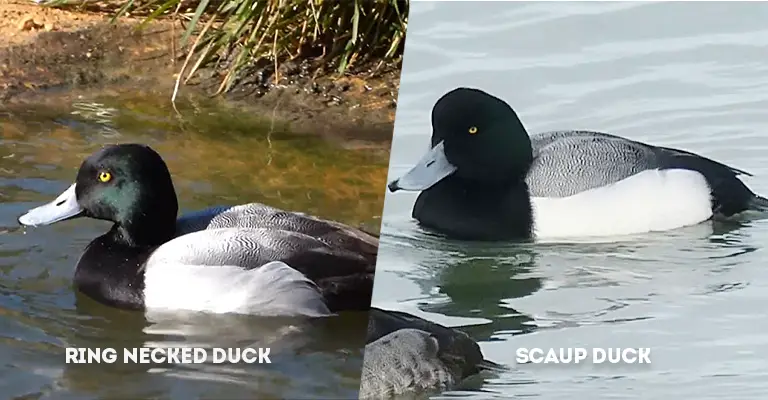
Key Differences Between Greater Scaup and Lesser Scaup
Here’s a text-based representation of the table listing the key differences between greater scaup and lesser scaup:
Plumage Colors
- Greater Scaup: The plumage of the greater scaup (Aythya marila) is characterized by a dark blackish head, white flanks, and a gray back.
This combination of colors creates a stark contrast between the dark head and the lighter body, making them easily recognizable. The dark head extends down the neck and transitions into the white flanks along the sides of the body. - Lesser Scaup: Similarly, the lesser scaup (Aythya affinis) also features a dark blackish head, white flanks, and a gray back. This resemblance in plumage can make distinguishing between the two species challenging, especially at a distance.
The dark head coloration extends down the neck, meeting the white flanks, and is followed by the gray back.
Wing White Marking

- Greater Scaup: One of the key differences between the two species lies in the white markings on their wings. In greater scaup, both the primary and secondary feathers have white markings that extend nearly to the tip of the wing. This creates a prominent and extensive white wing patch when the wings are spread.
- Lesser Scaup: On the other hand, lesser scaup have a different wing pattern. They also have white markings, but these are limited to the secondary feathers only.
Unlike the greater scaup, the white markings on the lesser scaup’s wings do not extend as far towards the wingtip. As a result, the white wing patch on the lesser scaup is smaller and less pronounced compared to that of the greater scaup.
White Wing Extent
- Greater Scaup: When observing the white wing extent of the greater scaup (Aythya marila), a distinguishing feature becomes evident. Their wings display a substantial white patch on both the primary and secondary feathers, reaching almost to the tip of the wing.
This extensive white marking contrasts distinctly against the dark body, facilitating identification, especially during flight. - Lesser Scaup: In contrast, the lesser scaup (Aythya affinis) showcases a different wing pattern. Their white wing extent is more limited and confined to the secondary feathers alone. This results in a smaller white wing patch that does not extend as far towards the wingtip as seen in the greater scaup.
Size
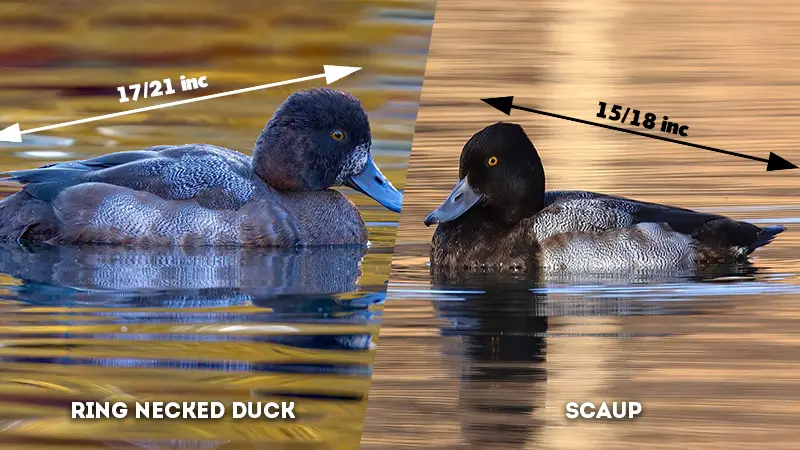
- Greater Scaup: Size serves as another factor to differentiate the two species. The greater scaup tends to be larger, with an average length ranging from 17 to 21 inches. This size disparity becomes evident when comparing the greater scaup with its relatively smaller counterpart.
- Lesser Scaup: The lesser scaup, in contrast, displays a smaller size, typically measuring between 15 to 18 inches in length. This difference in size between the two species is noticeable, aiding birdwatchers in distinguishing them based on their overall dimensions.
Wingspan
- Greater Scaup: When considering the wingspan of these two duck species, the greater scaup (Aythya marila) exhibits a larger wingspan compared to its counterpart. Typically, the wingspan of a greater scaup ranges from 30 to 33 inches.
This broader wingspan contributes to their ability to cover more ground during flight and aids in their long-distance migratory patterns. - Lesser Scaup: In contrast, the lesser scaup (Aythya affinis) has a relatively smaller wingspan, averaging between 26 to 30 inches. This smaller wingspan is reflective of their smaller overall body size and also influences their flight characteristics and behavior.
Bill Color
- Greater Scaup: Both species share a similar bill coloration—a bluish hue with a distinctive black tip. However, the greater scaup’s bill might appear slightly more robust due to their larger size. This bluish bill color is an adaptation suited for their aquatic lifestyle, where they forage for food beneath the water’s surface.
- Lesser Scaup: Like the greater scaup, the lesser scaup also possesses a bluish bill with a black tip. However, owing to their smaller size, their bill might appear relatively more delicate. This bill coloration serves them well as they dive for their preferred food sources.
Bill-to-forehead Slope
- Greater Scaup: The angle between the forehead and the bill is more abrupt in greater scaup. This creates a noticeable and distinct separation between the forehead and the bill’s base. This feature, while subtle, contributes to their overall facial appearance.
- Lesser Scaup: In comparison, the lesser scaup’s forehead-to-bill angle is more gradual. The transition from the forehead to the bill is smoother and less pronounced. This characteristic, when observed closely, aids in distinguishing between the two species.
Breeding Range
- Greater Scaup: Greater scaup are known for their breeding range in the northern regions of North America. During the breeding season, they can be found nesting in areas such as the boreal forests of Canada and Alaska. Their preference for these higher latitudes is a key aspect of their breeding behavior.
- Lesser Scaup: Similarly, the lesser scaup also breeds in North America, but their breeding range is somewhat more extensive.
They breed across a broader swath of North America, including the northern United States and southern Canada. This variation in breeding range can influence their interactions with other bird species and their local habitats.
Wintering Habitat
- Greater Scaup: As winter approaches, greater scaup undertake impressive migratory journeys to escape the harsh northern winters.
They migrate to more temperate regions of North America, often congregating in freshwater bodies such as lakes, ponds, and rivers. These areas provide suitable wintering habitat and access to the resources they require. - Lesser Scaup: Like their greater counterparts, lesser scaup are also migratory birds that seek refuge from colder climates.
During the winter months, they migrate to similar habitats—lakes, ponds, and rivers—across a broader range of North America, including both the United States and southern Canada. This flexibility in their wintering habitat contributes to their adaptability.
Vocalizations
- Greater Scaup: The vocalizations of greater scaup (Aythya marila) exhibit distinct patterns that help differentiate them from other duck species. Their calls often include a mix of grunting and whistling sounds.
These vocalizations play a role in communication, particularly during courtship and interactions with other members of their species. - Lesser Scaup: Lesser scaup (Aythya affinis) have their own unique vocalizations that set them apart. Their calls can be described as a mix of soft, high-pitched whistles and grunts. These vocal cues are crucial for mate selection, territory establishment, and general communication among the ducks.
Head Shape
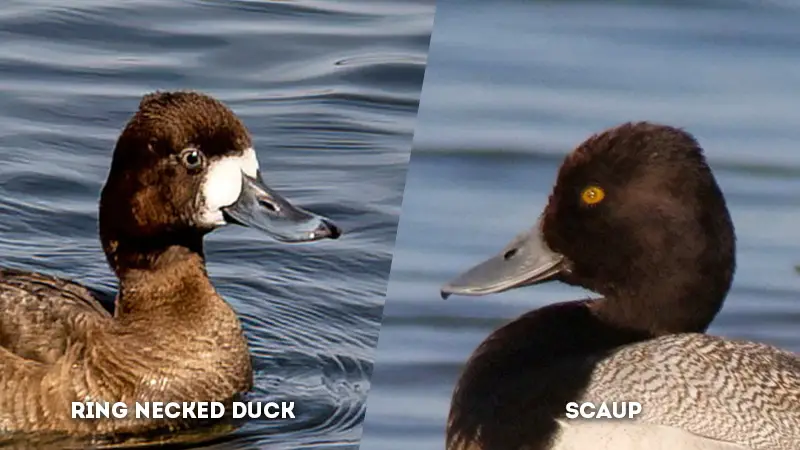
- Greater Scaup: One of the subtle yet noteworthy distinctions between the two species lies in the shape of their heads. Greater scaup have slightly more rounded heads, which might contribute to their appearance of having a larger and more robust head compared to their body size.
- Lesser Scaup: In contrast, lesser scaup have heads that appear relatively flatter or less rounded. This head shape, when combined with other features, aids in distinguishing between the two species, particularly when observing them from various angles.
Back Color
- Greater Scaup: Both greater and lesser scaup share a grayish back color. However, in greater scaup, the gray on the back might appear slightly darker or more pronounced. This subtle difference can be noticeable when observing the ducks in various lighting conditions.
- Lesser Scaup: Lesser scaup also exhibit a gray back, but the shade of gray might appear slightly lighter or less intense compared to that of the greater scaup. This slight variation contributes to the overall differentiation between the two species.
Flank Color
- Greater Scaup: The flank coloration of greater scaup is characterized by white flanks that contrast vividly against their dark body. The white flanks extend from the sides of the body and meet the darker head and back, creating a distinctive and eye-catching pattern.
- Lesser Scaup: Similar to their larger counterparts, lesser scaup also have white flanks that contrast against their dark body. The white flanks contribute to the overall contrast of their plumage, making them visually appealing and easier to identify.
Tail
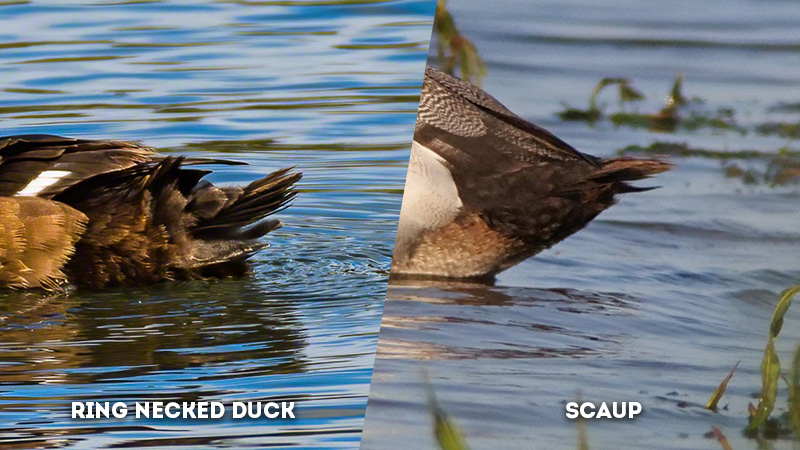
- Greater Scaup: The tail feathers of greater scaup are primarily black, adding to their overall color contrast. This black tail is especially noticeable during flight and can aid in identification from a distance.
- Lesser Scaup: Like the greater scaup, the lesser scaup also possesses black tail feathers. This commonality in tail color further highlights their shared characteristics, requiring observers to consider other distinguishing features for accurate identification.
Eye Color
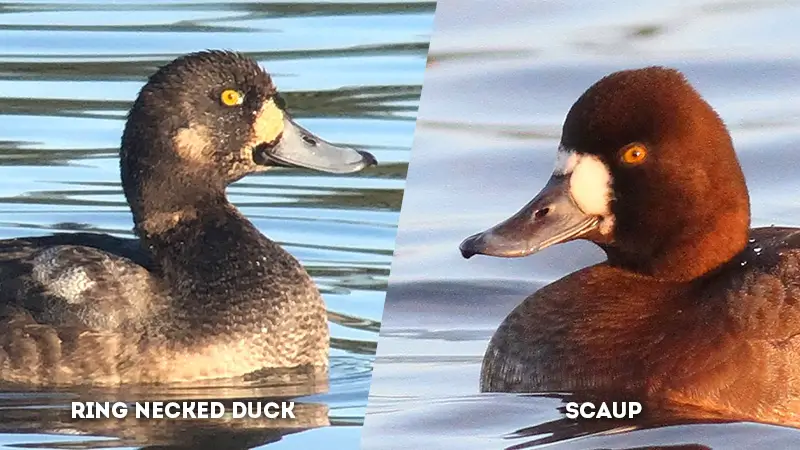
- Greater Scaup: The eye color of greater scaup (Aythya marila) is a distinctive feature that aids in their identification. They have striking yellow eyes that stand out against their dark head. This vivid eye color adds to their overall visual appeal and can be observed even at a distance.
- Lesser Scaup: Similarly, the lesser scaup (Aythya affinis) also possesses yellow eyes. Like their greater counterparts, the yellow eye color contrasts against the dark head and contributes to their unique appearance.
Overall Coloration
- Greater Scaup: The overall coloration of the greater scaup is characterized by the striking contrast between their dark blackish head, white flanks, and gray back. This combination of colors creates a visually captivating pattern that makes them stand out, even from a distance.
- Lesser Scaup: The lesser scaup shares a similar overall coloration pattern with a dark blackish head, white flanks, and gray back. While their overall appearance is reminiscent of the greater scaup, the specific distribution and intensity of colors might differ slightly.
Forehead
- Greater Scaup: When examining the forehead of the greater scaup, one can notice a relatively more abrupt angle between the forehead and the bill’s base. This contributes to the distinct facial profile that aids in their identification.
- Lesser Scaup: In contrast, the forehead-to-bill slope of the lesser scaup is more gradual. This results in a smoother transition between the forehead and the bill. While this feature might be subtle, it serves as a key characteristic for differentiation.
Neck Length
- Greater Scaup: The neck of the greater scaup tends to be shorter in proportion to their body size. This neck length, when combined with their rounded head, contributes to their overall appearance and body proportions.
- Lesser Scaup: Lesser scaup, too, have a relatively short neck. However, when compared to their overall size, their neck might appear slightly longer than that of the greater scaup. This variation in neck length is another aspect to consider when identifying these species.
Tail Shape
- Greater Scaup: The tail shape of the greater scaup (Aythya marila) is generally square or slightly rounded. This tail shape is a characteristic shared among many diving duck species and is adapted for their aquatic lifestyle, aiding in their maneuverability while swimming and diving for food.
- Lesser Scaup: Similar to the greater scaup, the lesser scaup (Aythya affinis) also has a square or slightly rounded tail shape. This tail adaptation is well-suited for their diving behaviors and movement through water.
Habitat
- Greater Scaup: Greater scaup primarily inhabit freshwater bodies such as lakes, ponds, and rivers. They are often found in northern regions of North America during their breeding season and migrate to more temperate areas for winter.
- Lesser Scaup: Lesser scaup share a similar habitat preference, favoring lakes, ponds, and rivers as well. They breed across a broader range in North America and also migrate to more southerly areas during winter.
Breeding Behavior
- Greater Scaup: Greater scaup typically engage in monogamous breeding behavior, forming pairs that last through the breeding season. During this time, they select suitable nesting sites in northern regions with ample water and cover for their nests.
- Lesser Scaup: Similarly, lesser scaup also exhibit monogamous breeding behavior. They establish pairs during the breeding season and seek out nesting sites in northern areas. The nesting process is an important aspect of their annual life cycle.
Feeding Habits
- Greater Scaup: Greater scaup have specialized feeding habits, primarily diving underwater to forage for their food. They consume a diet consisting of mollusks, aquatic insects, and aquatic plants. Their unique adaptations for diving enable them to reach these food sources below the water’s surface.
- Lesser Scaup: Lesser scaup share similar feeding habits with their greater counterparts. They are skilled divers, venturing underwater to feed on mollusks, aquatic invertebrates, and submerged vegetation. This feeding behavior is crucial for meeting their energy requirements.
Migration
- Greater Scaup: Greater scaup are known for their extensive long-distance migrations. During the colder months, they undertake impressive journeys, traveling from their breeding grounds in northern regions to more temperate areas for winter.
This migratory behavior is driven by the need to find suitable food and habitat during the colder months. - Lesser Scaup: Similarly, lesser scaup are migratory birds that also embark on long-distance journeys. They migrate from their breeding areas in the northern United States and Canada to more southerly regions for the winter. These migratory patterns play a crucial role in their survival and distribution.
Body Shape
- Greater Scaup: The body shape of the greater scaup is characterized by its rounded and relatively bulky appearance. This shape, combined with other physical features, contributes to their overall profile and aids in their buoyancy and diving behavior.
- Lesser Scaup: In comparison, the lesser scaup has a similar body shape, also displaying a rounded and somewhat compact appearance. Like the greater scaup, this body shape is an adaptation that facilitates their diving and swimming capabilities.
Head Glossiness
- Greater Scaup: The head of the greater scaup tends to appear duller in terms of glossiness. This characteristic might contribute to a slightly muted appearance of their dark heads, especially under certain lighting conditions.
- Lesser Scaup: Lesser scaup, on the other hand, often exhibit a glossier appearance on their dark heads. The sheen or glossiness can create a distinctive contrast against their white flanks and contribute to their visual appeal.
Populations
- Greater Scaup: The populations of greater scaup have generally been more stable compared to those of the lesser scaup. This relative stability might be attributed to their broader breeding range and adaptability to various aquatic habitats.
- Lesser Scaup: In contrast, populations of lesser scaup have faced some challenges, with certain populations experiencing declines. Factors such as habitat loss, water pollution, and changes in food availability have contributed to these population fluctuations.
Greater Scaup Vs Lesser Scaup: Comparison Table
| Feature | Greater Scaup | Lesser Scaup |
|---|---|---|
| Plumage Colors | Dark head, white flanks, gray back | Dark head, white flanks, gray back |
| Wing White Marking | White on primaries and secondaries | White on secondaries only |
| White Wing Extent | Extends nearly to wing tip | Limited white patch on secondaries |
| Size | Larger (17-21 inches) | Smaller (15-18 inches) |
| Wingspan | 30-33 inches | 26-30 inches |
| Bill Color | Bluish with black tip | Bluish with black tip |
| Bill-to-Forehead Slope | More abrupt slope | More gradual slope |
| Breeding Range | Northern North America | Northern North America |
| Wintering Habitat | Freshwater bodies | Freshwater bodies |
| Vocalizations | Different calls and vocal patterns | Different calls and vocal patterns |
| Head Shape | Rounded head | Rounded head |
| Back Color | Gray back | Gray back |
| Flank Color | White flanks | White flanks |
| Tail | Black tail feathers | Black tail feathers |
| Eye Color | Yellow eyes | Yellow eyes |
| Overall Coloration | Contrast between dark head and white body | Contrast between dark head and white body |
| Forehead | Blunt angle with bill | Gradual angle with bill |
| Neck Length | Short neck | Short neck |
| Tail Shape | Square tail | Square tail |
| Habitat | Lakes, ponds, rivers | Lakes, ponds, rivers |
| Breeding Behavior | Monogamous pairs | Monogamous pairs |
| Feeding Habits | Diving for mollusks and aquatic plants | Diving for mollusks and aquatic plants |
| Migration | Long-distance migration | Long-distance migration |
| Body Shape | Round body shape | Round body shape |
| Head Glossiness | Duller head | Glossier head |
| Populations | Generally stable populations | Some populations declining |
Frequently Asked Questions
Greater scaup produce a mix of grunting and whistling sounds, while lesser scaup’s vocalizations include soft, high-pitched whistles and grunts. These distinct calls aid in communication and interactions within their respective species.
Populations of greater scaup have generally remained more stable due to their adaptability to various habitats and broader breeding range. Lesser scaup populations, however, have faced challenges such as habitat loss, pollution, and changes in food availability, leading to population fluctuations.
Both species of scaup undertake long-distance migrations to escape harsh winters. They rely on their strong flying abilities and specialized diving adaptations to find suitable habitats and food sources during their wintering months in more temperate regions.
The glossiness of the head is more pronounced in lesser scaup compared to greater scaup. This glossiness contributes to their appearance and can aid in differentiation, especially when considering other physical characteristics like body size and plumage patterns.
Greater scaup’s stable populations can be attributed to their broader habitat adaptability and distribution. In contrast, lesser scaup populations can be more sensitive to changes in their habitats due to their narrower breeding range, making them potentially more susceptible to environmental disruptions.
To Recap
In the world of waterfowl, the greater scaup and lesser scaup stand as testament to nature’s ability to craft subtle variations within seemingly similar forms.
From their vocalizations echoing across wetlands to their graceful migrations across vast distances, these ducks encapsulate the marvel of adaptation and diversity.
While their shared characteristics serve as a bridge between their worlds, their unique traits, such as the extent of wing markings and the glossiness of their heads, allow enthusiasts to uncover the intricate threads that weave their stories.
Through these distinctions, greater and lesser scaup illuminate the beauty of nature’s complexity and the wonder it inspires in those who seek to understand it.